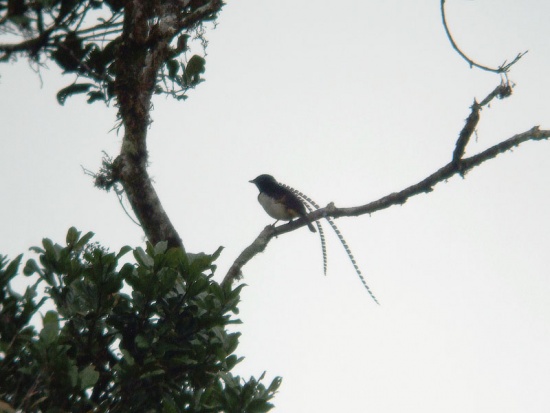Alternative names: Enamelled Bird-of-paradise
- Pteridophora alberti
Identification
Male 22cm, female 20cm.
Male
- Velvety black head, mantle and back with iridescent sheen of bronzed green
- Two very long, scalloped, enamel blue brow plumes that can be erected at the bird’s will
- Black chin and throat
- Dark yolk-yellow underparts with creamy feathering on flanks
- Dark brown eye
- Black bill
- Pale to rich aqua-green mouth
- Dark brownish-grey legs
Female
- Sooty grey upperparts and most of head
- Buffy grey chin, throat and neck sides with broad dark brownish-grey barring
- Whitish rest of underparts with open, shallow, blackish-brown chevrons
Juveniles are undescribed, immature males first resemble females.
Distribution
Found in the central mountain ranges of New Guinea from Weyland Mountains discontinuously east to Kratke Range.
Widespread and often common in its small range.
Taxonomy
This is a monotypic species.
Birds from Schraderberg are described as subspecies buergersi and birds from the southern slope of Mount Hagen as hallstromi, but both are usually not accepted.
Habitat
Middle to upper montane forest, also around hunting lodges and tracks. Occurs at 1400 - 2850m, mainly at 1800 - 2500m.
Behaviour
Diet
Feeds mostly on fruits, takes also insects and spiders. Forages usually singly by tearing and probing at mosses and lichens.
Breeding
Breeding possible in all months, peak from July to February. A polygynous species. The male advertises by singing from a prominent perch. If a female approaches it changes to the ground to perform a complex display. The female builds and attends the nest alone.
Only one nest described. It was a shallow cup made of fine stems of orchids and fern fronds, placed 11m above the ground in a tree fork. It contained 1 egg.
Movements
Presumably a resident species.
References
- Clements, JF. 2009. The Clements Checklist of Birds of the World. 6th ed., with updates to December 2009. Ithaca: Cornell Univ. Press. ISBN 978-0801445019.
- Del Hoyo, J, A Elliott, and D Christie, eds. 2009. Handbook of the Birds of the World. Volume 14: Bush-shrikes to Old World Sparrows. Barcelona: Lynx Edicions. ISBN 978-8496553507
Recommended Citation
- BirdForum Opus contributors. (2024) King of Saxony Bird-of-Paradise. In: BirdForum, the forum for wild birds and birding. Retrieved 27 April 2024 from https://www.birdforum.net/opus/King_of_Saxony_Bird-of-Paradise




